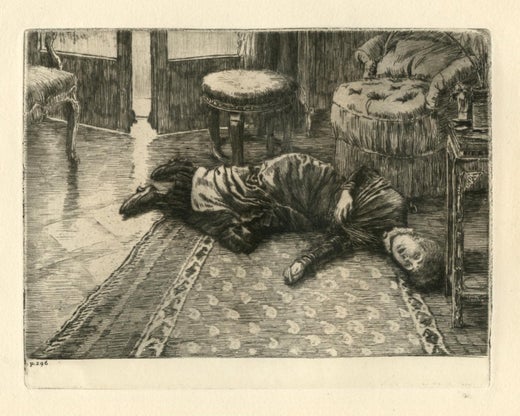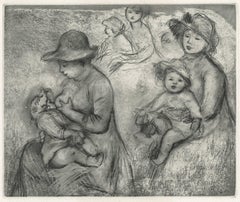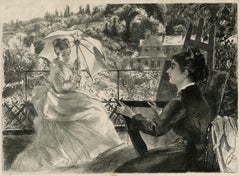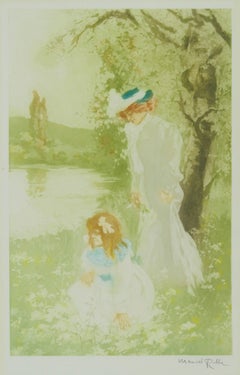Want more images or videos?
Request additional images or videos from the seller
1 of 10
James Jacques Joseph TissotL'enfant prodigue: en pays etranger (The Prodigal Son: In Foreign Climes)1881
1881
$2,000List Price
About the Item
- Creator:James Jacques Joseph Tissot (1836-1902, French)
- Creation Year:1881
- Dimensions:Height: 12.25 in (31.12 cm)Width: 14.75 in (37.47 cm)
- Medium:
- Movement & Style:
- Period:
- Condition:
- Gallery Location:Fairlawn, OH
- Reference Number:Seller: FA66891stDibs: LU14013075262
James Jacques Joseph Tissot
Jacques Joseph Tissot (French: [tiso]; 15 October 1836 – 8 August 1902), Anglicized as James Tissot (), was a French painter and illustrator. He was a successful painter of Paris society before moving to London in 1871. He became famous as a genre painter of fashionably dressed women shown in various scenes of everyday life. He also painted scenes and figures from the Bible.
About the Seller
5.0
Recognized Seller
These prestigious sellers are industry leaders and represent the highest echelon for item quality and design.
Platinum Seller
Premium sellers with a 4.7+ rating and 24-hour response times
Established in 1978
1stDibs seller since 2013
814 sales on 1stDibs
Associations
International Fine Print Dealers Association
Authenticity Guarantee
In the unlikely event there’s an issue with an item’s authenticity, contact us within 1 year for a full refund. DetailsMoney-Back Guarantee
If your item is not as described, is damaged in transit, or does not arrive, contact us within 7 days for a full refund. Details24-Hour Cancellation
You have a 24-hour grace period in which to reconsider your purchase, with no questions asked.Vetted Professional Sellers
Our world-class sellers must adhere to strict standards for service and quality, maintaining the integrity of our listings.Price-Match Guarantee
If you find that a seller listed the same item for a lower price elsewhere, we’ll match it.Trusted Global Delivery
Our best-in-class carrier network provides specialized shipping options worldwide, including custom delivery.You May Also Like
"Study 2", Seated Figure Lithograph
By Jim Smyth
Located in Soquel, CA
Beautiful nude figurative lithograph by Jim Smyth (American, b. 1938). Numbered, titled, signed and dated "8/12", "Study 2", "Smyth 75” along the bottom edge. Unframed.
Jim Smyth has studied at the Academia de Belle Arti in Fiorenza, Italy, Ecole des BeauxArts in Geneva, New York Academy, and the Art Students League. He is also a graduate of UC Berkeley with a degree in Fine Art.
Although academically trained, Smyth practices and teaches a more impressionistic style of painting, focusing on the Alla Prima technique.
He is particularly knowledgeable about drawing, perspective, color theory and the human figure, his passion. Smyth, with extensive academic knowledge, has a profound love of all human representations as illustrated by his humorous quick sketches from life. He also practices and teaches oil painting and pastels.
When not in Provence, or Southeastern France, Smyth teaches intensely in art schools, art centers and several colleges in the Bay Area. He is a beloved instructor and his classes fill in quickly as he is very knowledgeable.
On his return to the United States, he began studying with Mr. Alanson Appleton at the College of San Mateo, San Mateo, California. Smyth was a founding member of the Appletree Etchers, Inc., an etching print shop organized by Mr. Appleton and his students to develop and promote color intaglio. Smyth served as Master Printer at the studio for many years perfecting the techniques of intaglio and developing the color theories of Mr. Appleton as applied to the deeply etched plate.
Smyth received his degree from the University of California, Berkeley, in 1972 and holds the California Community College Certificate and an Adult Education Certificate. Smyth was invited to teach "Anatomy for Artists" at Foothill College, Los Altos Hills, California, as a result of his many years of dissection of the cadaver and developed the course of study of Perspective for the college. During this period, he began teaching Life Drawing at the Pacific Art League of Palo Alto, Palo Alto, California. During the following thirty years Smyth has taught an average of twelve classes per week at the Pacific Art League of Palo Alto, the Palo Alto Art Center and the Burlingame Recreation Department among others in all phases of drawing and painting. He has conducted many workshops for the California Academy of Painters in many aspects of drawing and painting. Currently, he is an Adjunct Professor of Drawing at the College of San Mateo, San Mateo, California. He is an authority on the materials of painting and drawing, techniques of traditional drawing and painting, color theory, perspective and anatomy for artists. In his career in Life Drawing, Smyth has made over two hundred thousand drawings from the model.
In addition to studies at Berkeley, Smyth has studied at the College of San Mateo, Foothill College, De Anza College, Mission College, and West Valley College, all in California. One of the pivotal points in his career was studying with Mr. Maynard Dixon Stewart at the University of San Jose, California. He spent a year at the New York Academy of Art where he was offered a full scholarship and at the Art Students League of New York. He concurrently attended classes at the National Academy of Design in New York. Among others, Smyth studied with M. Andrejivec, Ted Schmidt, Elliot Goldfinger, Gary Fagin, Ted Jacobs, Leo Neufeld, David Leffel, Jack Ferragasso, Jim Childs and Everett Raymond Kinstler and Kim English. Smyth has also studied with the noted painter and colorist, Ovanes Berberian. In 2002 Jim was invited to study at the Academy of Art in St. Petersburg, Russia, where he worked in Life Drawing and Life Painting.
Smyth is a popular lecturer, a sought after demonstrator and juror. He is the recipient of many awards for both his painting and his teaching. In 1988 and again in 2003, he received the Kenneth Washburn...
Category
1970s American Impressionist Figurative Prints
Materials
Paper, Etching
Le Bouquet de Violettes (The Bouquet of Violets) /// Figurative Impressionist
By Manuel Robbe
Located in Saint Augustine, FL
Artist: Manuel Robbe (French, 1872-1936)
Title: "Le Bouquet de Violettes (The Bouquet of Violets)"
*Signed by Robbe in pencil lower right
Year: 1903
Medium: Original Hand-Colored Etc...
Category
Early 1900s Impressionist Figurative Prints
Materials
Etching, Aquatint, Watercolor, Laid Paper, Intaglio
$1,000 Sale Price
75% Off
H 28 in W 21.5 in
L'Avant-Foyer de l'Opera /// French Impressionist Etching Figurative Lady Man
By Tony Minartz
Located in Saint Augustine, FL
Artist: Tony Minartz (French, 1873-1944)
Title: "L'Avant-Foyer de l'Opera"
Portfolio: Revue de l'Art Ancien & Moderne
*Issued unsigned
Year: 1903
Medium: Original Etching on cream laid paper
Limited edition: Unknown
Printer: Unknown
Publisher: Revue de l'Art Ancien & Moderne, Paris, France
Framing: Recently framed in a traditional gold and black moulding with 100% cotton rag matting
Framed size: 18.63" x 16.38"
Sheet size: 12" x 9"
Image size: 9" x 7.25"
Condition: In excellent condition
Notes:
Printed in one color: bistre.
This review was founded in 1897 in the continuity of the review Les Beaux-Arts published between 1861 and 1865; Jules Comte, the founder, entitled his first issue Les Beaux-Arts - Revue nouvelle then changed the title to La Revue de l'art ancien et moderne. Jules Comte directed the review until his death in 1912. Raymond Woog took over , who was provisional director until the start of the war in July 1914. In 1919, André Dezarrois took over this review and was its director until December 1937, date of last issue (published in January 1938). In the meantime, it publishes the Bulletin of ancient and modern art, which has gained a certain notoriety in the community.
Biography:
Tony Minartz, pseudonym of Antoine Guillaume, born 8 April 1873 to Cannes and died in that city on 13 December 1944 Is a painter, draftsman , illustrator and engraver French.
Painter autodidact , Tony Minartz starts to become known in 1896 by exhibiting paintings at the Salon of the National Society of Fine Arts , and then decorates the Pompadour theater of painted panels for fashion shows " Grand Guignol ", directed by L. Darthenay. In 1903, Henri Béraldi , with whom he worked, praised him in The Journal of ancient and modern art, writing that "it was thirty years ago," and he has received advice from Paul Renouard to be formed the technique of etching ; Béraldi adds that his favorite subjects are "Paris at night Paris at night, always." Minartz also gives them some high-remarkable in The Journal of ancient and modern art until 1910: balls, cafe concerts, Parisian in their most beautiful dresses, but also music-halls, music halls, restaurants, large and small theaters, are the preferred settings of his compositions.
Its fertile period seems to end in 1914. In addition to the National Salon, Minartz exhibited in Paris at the gallery Bartholomew (1903), the Independent Living (1905, 1906) and the gallery Devambez (1909) and received the Academic Palms . He occasionally collaborates with periodic illustrated as The Almanac Sports (Ollendorff, 1899), or satirical as Gil Blas...
Category
Early 1900s Impressionist Figurative Prints
Materials
Laid Paper, Intaglio, Etching
$350 Sale Price
54% Off
H 18.63 in W 16.38 in
Lonely dreamers .1992. Paper, etching, watercolor, 22x14 cm
Located in Riga, LV
Lonely dreamers
1992. Paper, etching, watercolor, 22x14 cm.
Roman Lapp (1961. 24. VII Moscow) – painter
Artist learned drawing to M. Zuhovickis.
He graduated Art Academy of Latvia,...
Category
1990s Impressionist Figurative Prints
Materials
Paper, Watercolor, Etching
$462 Sale Price
20% Off
H 8.67 in W 5.52 in D 0.4 in
Jules Pascin (French, 1885-1930) "Two Women Reclining" Original Etching C.1920
By Jules Pascin
Located in San Francisco, CA
Jules Pascin (French, 1885-1930) "Two Women Reclining" Original Etching C.1920
Plate dimensions 9" wide x 12" high
Frame dimensions 19.5" wide x 26.5" high
Plate signed
The etchi...
Category
Early 20th Century Impressionist Figurative Prints
Materials
Etching
$850
H 26.5 in W 19.5 in D 1 in
Gerald Brockhurst (1890-1978) "Fabian" Pencil Signed Etching c.1921
By Gerald Leslie Brockhurst
Located in San Francisco, CA
Gerald Brockhurst (1890-1978) Pencil Signed Etching "Fabian" c.1921
Fine etching by noted artist Gerald Brockhurst.
Titled "Fabian" from an edition of 76.
This etching is in excel...
Category
Early 20th Century Impressionist Portrait Prints
Materials
Etching
$475
H 14 in W 12 in D 1 in
Lovis Corinth (German, 1859-1925) "Pieta" Rare Etching c.1920
By Lovis Corinth
Located in San Francisco, CA
Lovis Corinth (German, 1859-1925) Rare Etching c.1920
Fine etching by noted German Expressionist artist Lovis Corinth.
This striking imag...
Category
Early 20th Century Impressionist Figurative Prints
Materials
Etching
$1,250
H 16.5 in W 19 in D 3 in
"Le Portique de la Galerie Nationale a Londres" etching by Tissot
By James Jacques Joseph Tissot
Located in Hinsdale, IL
TISSOT, JAMES JACQUES JOSEPH
(1836 - 1902)
"Le Portique de la Galerie Nationale a Londres"
(The Portico of the National Gallery, London)
Wentworth 40
Etching and Drypoint on imitation Japanese paper, C. 1878
Only state published, from the edition of 100
Signed 1878 J.J. Tissot on the step, lower right
14 7/8” x 8 1/4”
Excellent crisp impression
This etching is related to the painting London Visitors exhibited at the Royal Academy in 1874, no. 116. The setting is the portico of the National Gallery, looking toward the Church of St. Martin’s-in-the-Fields. Such works give Tissot a minor but distinguished position as a predecessor of the school of architectural etchers...
Category
Late 19th Century Impressionist Figurative Prints
Materials
Etching
$11,500
H 29 in W 22 in D 2 in
Venus
By James Abbott McNeill Whistler
Located in New York, NY
A brilliant, richly-inked impression of this etching and drypoint printed in dark brownish black on antique cream laid paper with very strong contrasts....
Category
1850s Impressionist Nude Prints
Materials
Drypoint, Etching
Lady Hailing a Carriage - German Impressionism Berlin
By Lesser Ury
Located in London, GB
This original etching and drypoint is hand signed in pencil by the artist "L. Ury" at the lower left margin.
It is also hand numbered in pencil from the edition of 150, at the lower ...
Category
1910s Impressionist Figurative Prints
Materials
Drypoint, Etching
More From This Seller
View AllL'enfant prodigue: en pays etranger (The Prodigal Son: In Foreign Climes)
By James Jacques Joseph Tissot
Located in Fairlawn, OH
L'enfant prodigue: en pays etranger (The Prodigal Son: In Foreign Climes)
Etching, 1881
Unsigned (as usual for this state)
From: L'enfant prodigue, (The Prodigal Son, five plates)
Ed...
Category
1880s Impressionist Figurative Prints
Materials
Etching
Trois Esquisses de maternite (Three Studies of Maternity)
By Pierre Auguste Renoir
Located in Fairlawn, OH
After Pierre Auguste Renoir (1841-1919)
Trois Esquisses de maternite (Three Studies of Maternity)
Heliogravure with etching on velin paper, 1893
Unsigned as issued
Edition 1000, ther...
Category
1890s Impressionist Figurative Prints
Materials
Etching
La Terrasse de la Villa Brancas, Sevres (The Terrace of the Villa Brancas)
By Félix Bracquemond
Located in Fairlawn, OH
La Terrasse de la Villa Brancas, Sevres (The Terrace of the Villa Brancas)
etching & drypoint, 1876
Signed in the plate bottom right corner (see photo)
in plate, at lower left: xbre ...
Category
1870s Impressionist Figurative Prints
Materials
Etching
Avril
By Manuel Robbe
Located in Fairlawn, OH
Avril (April)
Color aquatint and etching, c. 1906
Signed in pencil lower right
Edition: c. 100
Excellent impression, fresh colors
Reference: Merrill Chase Volume 1, No. 9
Condition: ...
Category
Early 1900s Impressionist Figurative Prints
Materials
Aquatint
A la Corrida
Located in Fairlawn, OH
A la Corrida
Color aquatint, c. 1900
Signed "Osterlind" lower right in red pencil
Annotated: "No. 96" in pencil lower left
Edition: about 100
Published by Sagot, Paris: their blindst...
Category
Early 1900s Impressionist Figurative Prints
Materials
Aquatint
Le Gamin (The Kid)
By Édouard Manet
Located in Fairlawn, OH
Le Gamin (The Kid)
Etching on laid paper, 1862
Signed in the plate upper left (see photo)
As published in Theodore Duret, L'Histoire d'Edouard Manet et de Son Ouvre, 1902 (The first ...
Category
1860s Impressionist Figurative Prints
Materials
Etching
Recently Viewed
View AllMore Ways To Browse
Andrew Wyeth Signed And Numbered Prints
Andy Warhol Electric Chairs
Ben Shahn Martin Luther King
Bus Stop Sign
Cain And Abel
Calder Behind The Mirror
Corneille On Sale
Cundo Bermudez
Dali Death
Dali Flowers
Dali Hell
Dali Ronsard
Deux Femmes Nues
Enrico Baj On Sale
Feliks Topolski
Francois Gilot
George Soper
Isabel Rawsthorne




